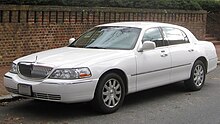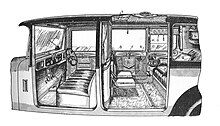Platinum Limousine Hire - The History of the Limousine
A limousine (or limo) was originally an "enclosed automobile with open driver's seat," and was named from the French limousine (in the Occitan language) that was originally an adjective referring to a region in central France. The automobile meaning evolving from a type of cloak and hood that was worn by the inhabitants of the Limousin region that later resembled the covering of a carriage and much later used to describe an automobile body with a permanent top that extended over the open driver's compartment.
The term now refers to a luxury sedan or saloon car, especially one with a lengthened wheelbase or driven by a chauffeur. The chassis of a limousine may have been extended by the manufacturer or by an independent coachbuilder. These are called "stretch" limousines and are traditionally black or white. Limousines are usually liveried vehicles, driven by professional chauffeurs. As the most expensive form of automobile ground transportation, limousines are culturally associated with extreme wealth or power and are commonly cited as examples of conspicuous consumption. Among the less wealthy, limousines are often hired during special events (most commonly weddings, proms, and bachelor parties).
While some limousines are owned by individuals, many are owned by governments to transport senior politicians, by large companies to transport executives, and by broadcasters to transport guests.
Most stretch limousines, however, operate as livery vehicles, providing upmarket competition to taxicabs. Builders of stretch limousines purchase stock cars from manufacturers and modify them, and most are in the United States and Europe and cater mainly to limousine companies. Few stretch limousines are sold new to private individuals. In addition to luxuries, security features such as armoring and bulletproof glass are available.
Limousine History

Winton Six Limousine, 1915, with driver in a compartment separate from the passengers, a distinctive limousine feature
The first automobile limousine, built in 1902, was designed so the driver sat outside under a covered compartment. The word limousine is derived from the name of the French region Limousin, because this covered compartment physically resembled the raised hood of the cloak worn by the shepherds there. An alternate etymology has the chauffeur wearing a Limousin-style cloak in the open driver's compartment, for protection from the weather.
The first “stretch limousine” was created in Fort Smith, Arkansas around 1928 by a coach company named Armbruster. These cars were primarily used to transport famous “big band” leaders, such as Glenn Miller and Benny Goodman, and their bands and equipment. These early stretch limousines were often called “big band buses”.
In 1916, the Society of Automobile Engineers defined a limousine as: "a closed car seating three to five inside, with driver's seat outside." A berline was defined as "a limousine having the driver's seat entirely inclosed", while a brougham was defined as "a limousine with no roof over the driver's seat."
Limousine types
The limousine body style has a divider separating the driver from the rear passenger compartment. This partition usually contains a sliding (often soundproof) glass window so that conversations between passengers in the rear compartment may be kept private from the chauffeur. Communication with the driver is possible either by opening the window in the partition or by using an intercom system. There are two alternative versions of the style. The Limousine-Landaulet has a removable or folding roof section over the rear passenger seat. The Limousine de-ville has a solid roof over the rear passengers but a removable or folding roof section over the driver's seat.
Traditional

1927-28 Lincoln Limousine used by US President Calvin Coolidge
Traditionally, the limousine has been an extension of a large car. A longer frame and wheelbase allow the rear passenger compartment to contain the usual forward-facing passenger seat but with a substantial amount of foot room — more than is actually needed. Where a vehicle is built for the funeral trade, one or two full width, normal, forwards facing seats are often added. These may be fixed or fold down into the floor. Otherwise two "jump seats" are mounted, facing rearward behind the driver. These seats fold up when not in use. In this way, up to five persons can be carried in the aft compartment in comfort, and up to two additional persons carried in the driver's compartment, for a total capacity of seven passengers in addition to the driver. This type of seat configuration has however become less popular in recent limousines, although this design, without the two front passenger seats, is still characteristic of London's famous Black Cabs, whose jump seats are referred to as taxi-tip-seats. The underside of these seats usually carry gaudy, adhesive advertising stickers, visible to the passengers when tip-seats are not in use.
Modern limousines

Maybach 62

US Presidential Cadillac DTS

Lincoln Town Car, base model used for modern limos in the United States and Canada
Such cars as the Toyota Century, Maybach 62, Rolls Royce Phantom, Audi A8L, Volkswagen Phaeton, Mercedes-Benz CLS-Class Mercedes-Benz S-Class, Jaguar XJ, BMW 7-Series, Lincoln Town Car Edition, Bentley Continental Flying Spur and the Cadillac DTS have no division between the driver and passengers and do not feature jump seats and are not limousines. So far as most people are concerned, stretch limousines are usually used to transport more than three passengers, excluding the driver. In production American limousines however, the jump seats almost always faced forward. The last production limousine, by Cadillac, with forward-facing jump seats was in 1987 (with their Fleetwood Series 75 car), the last Packard in 1954, and the last Lincoln in 1939, though Lincoln has offered limousines through their dealers as special order vehicles at times. Several Lincoln Premier cars were also built, one being owned by Elvis Presley. Vehicles of this type in private use may contain expensive audio players, televisions, video players, and bars, often with refrigerators.
It is simpler to determine the effects of altering a separate chassis than it is to determine the effects of altering a load-bearing unitized platform body. Coach builders have built models based on SUVs with a separate load-bearing chassis.
Traditional limousines today are Lincoln Town Car Stretch and Super Stretch Limousines. They are typically available in several models typically referred to by limousine companies as 6 passenger limousines, 8 passenger limousines, and 10 passenger limousines. The 6 passenger stretch limousines have two opposing seats, and seat 4 adults comfortable and up to 6 passengers maximum. The physical Length of these Limos are stretched 80 inches from a standard vehicle. The 8 passenger Super Stretch limousines have two opposing seats with a middle section, or a rear and back seat and a J configuration seat. The physical lengths of these Limos are stretched 100 inches from a standard vehicle. The 10 passenger ultra stretch limousines have a rear seat and a long J configuration seat. They seat 8 adults comfortable and up to 10 passengers maximum. Sometimes they also have a "fifth door" at the end of the J seat to allow wedding parties and larger groups easier access in and out of the limo. The physical lengths of these limos are stretched 120 inches from a standard vehicle.
Some limousine manufacturers have made some 12 passenger Super-Ultra Stretch Limousines that are for 12 passengers and stretched 140 inches. The weight requirements of these limos do not meet some/most states Department of Motor Vehicle Rules and Regulations. Also Limousine manufacturers are often challenged to meet safety, exhaust, weight, and other standards with longer vehicles that hold more passengers (weight).
The above 6, 8, and 10 configurations are available in Cadillac models, but are not as common.
Lincoln will stop producing commercial Lincoln Town Cars in 2012 for Commercial Limousine use and the market will significantly change its look in subsequent years.
The 12-14 passenger Super Stretch SUV limousine is manufactured by Ford Excursions and Expeditions, H2 Hummers, Cadillac ESV's. Their interiors offer much more room inside for seating, bars, speakers, lights, and comforts to make the limousines very luxurious. They (depending on their seating configurations) seat between 11-20 passengers and are stretched 140, 160, 180, and 200 inches.
The 18 and 28 and 38 passenger buses are three types of limousine interior buses that are common with most limousine companies. They are equipped with every conceivable luxury that is possible because of their size and shape. They have small stairs leading up to the bus, and also passengers can stand up in the buses. The buses are always equipped with "Air Ride" to make the ride comfortable for the passengers. These are regulated by the Department of Transportation and all drivers are required to have both a Passenger Endorsement and a Commercial Drivers License to drive these limo buses.
Feel the unique Limousine experience for
yourself with our extensive range of Limousines for hire
Platinum Limo Hire call now on:
Tel: 0800 0842 786 or Mob: 07432 786 786










